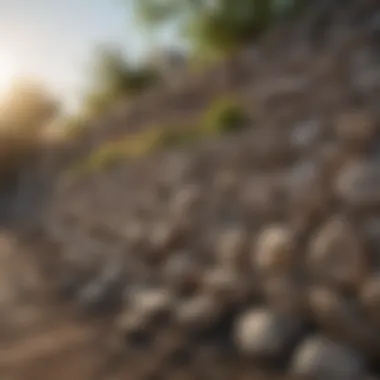Expert Guide on Proper Rock Disposal Techniques for Your Yard


Rock and Fossil Identification
In the realm of yard maintenance, understanding the types of rocks present is crucial. Different rocks can have varying characteristics, such as sedimentary, igneous, or metamorphic compositions. By familiarizing oneself with these distinctions, homeowners can better strategize the disposal process. Examining the rocks closely for details like color, texture, and mineral composition can aid in accurate identification. Additionally, utilizing tools like magnifying glasses, geology hammers, and acid tests can provide further insights into the types of rocks in the yard.
Collecting Tips and Techniques
When it comes to collecting rocks for disposal, adhering to best practices is essential. Identifying prime collection sites can lead to more efficient removal processes. Mostly, rocks can be found near excavation sites, natural cliffs, or riverbeds. Safely extracting rocks without causing damage to the surrounding area or oneself involves techniques like leveraging shovels, pry bars, and safety gear. By employing these strategies, homeowners can streamline the gathering of rocks for subsequent disposal.
Preservation and Display
Preserving rocks post-collection can prolong their lifespan and maintain their aesthetic appeal. Utilizing techniques such as staining, sealing, or painting can help protect rocks from environmental degradation. When storing rocks, opting for containers like labeled boxes or display cases ensures organization and easy access. Engaging in creative display ideas, such as creating a rock garden or incorporating rocks into artwork, can enhance the yard's visual appeal.
Geological Insights
Gaining geological insights can provide a broader perspective on the rocks present in the yard. Understanding geological formations and processes that led to the creation of specific rock types adds depth to the disposal process. Unveiling the historical significance of certain rocks or fossils can offer an enriching experience for collectors. Exploring notable discoveries in the field can foster greater appreciation for the rocks being disposed of, connecting homeowners to the larger geological narrative.
Understanding Rocks in Your Yard
Understanding the rocks present in your yard is crucial for efficient rock disposal. Identifying different types of rocks and assessing their size and quantity are essential steps in maintaining a well-manicured outdoor space. By understanding the composition and characteristics of rocks in your yard, you can determine the most suitable disposal methods, ensuring a harmonious landscaping environment.
Identifying Types of Rocks
Sedimentary Rocks
Sedimentary rocks, formed through the deposition and solidification of sediment, offer durability and versatility in landscaping projects. Their natural layering adds a unique aesthetic appeal to gardens and pathways. While sedimentary rocks may be relatively easier to handle due to their compact nature, their porous composition can sometimes lead to weathering or erosion over time, requiring occasional maintenance.


Metamorphic Rocks
Metamorphic rocks, resulting from the transformation of existing rock types under intense heat and pressure, provide strength and resilience in landscaping applications. Their ability to withstand environmental stressors makes them a popular choice for long-lasting rock features. However, the intricacies of their formation may make them harder to shape or manipulate for certain design preferences.
Igneous Rocks
Igneous rocks, originating from the cooling and solidification of molten lava or magma, offer durability and distinct textures suitable for various outdoor arrangements. Their unique colors and patterns add visual interest to rock gardens or decorative borders. While igneous rocks can be challenging to reshape once formed, their natural ruggedness enhances the overall rugged charm of outdoor spaces.
Assessing Rock Size and Quantity
Small Rocks
Small rocks, often referred to as pebbles or gravel, contribute to ground cover and drainage solutions in landscaping projects. Their compact size allows for intricate detailing in rock gardens or pathways. While easy to manage and arrange, small rocks may require frequent replenishment due to potential displacement or dispersal.
Large Rocks
Large rocks, commonly used as focal points or structural elements in outdoor designs, offer a sense of grandeur and permanence to landscaping features. Their substantial size provides visual impact and stability in rock arrangements. However, the weight and positioning of large rocks necessitate careful planning and strategic placement to prevent potential hazards or disruptions.
Rock Piles
Rock piles, created by stacking rocks of varying sizes and shapes, add a rugged and rustic aesthetic to outdoor settings. They are often utilized to create natural barriers or artistic installations in landscaping designs. While rock piles offer versatility and creativity in landscaping projects, their construction requires careful consideration of balance and stability to avoid collapses or reshaping over time.
Methods of Disposing of Rocks
DIY Rock Disposal


Reuse in Landscaping Projects
Exploring the option of Reuse in Landscaping Projects is a fundamental aspect when it comes to rock disposal. By repurposing rocks in landscaping endeavors, individuals can not only save costs but also contribute to sustainable practices within their yards. This eco-friendly approach allows for the transformation of outdoor spaces with minimal environmental impact, making it a popular choice for those seeking practical and environmentally conscious solutions to rock disposal in their yards.
Offering Rocks to Others
Offering Rocks to Others is a generous way to dispose of excess rocks while also benefiting those who may find a use for them. This method fosters community engagement and resource sharing, promoting goodwill among neighbors and fellow landscaping enthusiasts. The act of giving away rocks not only declutters one's yard but also fosters a sense of camaraderie within the community, making it a favorable choice for rock disposal in this comprehensive guide.
Creating a Rock Garden
Integrating a Rock Garden into your yard can be an artistic and functional approach to rock disposal. By strategically arranging rocks in a designated area, individuals can enhance the aesthetic appeal of their outdoor space while creating a unique focal point. Rock gardens require minimal maintenance and offer an opportunity for creative expression through landscaping, making them an attractive option for those looking to repurpose rocks artistically within their yards.
Professional Rock Disposal Services
Hiring a Landscaping Company
Opting to enlist the services of a professional Landscaping Company for rock disposal guarantees a seamless and efficient process. Professionals in the field possess the expertise and equipment necessary to handle rocks of varying sizes and quantities, ensuring a hassle-free experience for homeowners. Hiring a Landscaping Company not only saves time and effort but also ensures that rock disposal is conducted expertly, making it a prudent choice for those seeking professional assistance in maintaining their outdoor spaces.
Renting a Dumpster
Renting a Dumpster provides a convenient solution for disposing of large volumes of rocks effectively. This method is ideal for individuals undertaking extensive landscaping projects or yard clean-ups that generate a significant amount of rock debris. Renting a Dumpster offers a practical and centralized approach to rock disposal, allowing for easy collection and removal of rocks without the need for frequent trips to disposal sites, thus serving as a beneficial choice outlined in this article.
Donating Rocks
Donating Rocks presents a socially responsible way to dispose of unwanted rocks while contributing to charitable causes or community endeavors. By gifting rocks to organizations or individuals in need, homeowners can repurpose rocks that would otherwise go to waste, benefiting both the recipient and the environment. This altruistic approach to rock disposal not only reduces landfill contributions but also fosters a sense of goodwill and environmental stewardship, positioning it as a commendable option for individuals looking to make a positive impact through rock disposal.


Environmental Considerations
When it comes to effectively disposing of rocks in your yard, understanding the environmental considerations is paramount. This section delves into the significance of incorporating eco-friendly practices when handling rocks, emphasizing the broader impact on the ecosystem and surrounding environment.
Impact of Rock Disposal on Ecosystem
- Preventing Soil Erosion: Preventing soil erosion plays a crucial role in maintaining soil health and stability within your yard. By implementing practices that mitigate erosion caused by rock displacement, you can preserve the integrity of your landscaping, ensure long-term sustainability, and prevent the loss of valuable topsoil. Focusing on strategies such as contour farming and retaining walls can effectively minimize the erosion effects, offering a sustainable solution for rock disposal.
- Avoiding Water Contamination: Avoiding water contamination is a key consideration when disposing of rocks, as improper handling can lead to runoff pollutants infiltrating water sources. Implementing proper drainage systems and utilizing filtration methods can help safeguard water quality and prevent potential contamination. By prioritizing this aspect, you contribute to maintaining a clean and sustainable environment for both your yard and the broader ecosystem.
- Preserving Natural Habitat: Preserving the natural habitat amidst rock disposal activities is crucial for supporting local flora and fauna. By considering the impact of rock removal on existing ecosystems, you can take steps to minimize disruption and protect biodiversity. Creating designated rock disposal areas away from sensitive habitats and incorporating nature-friendly practices ensures minimal disturbance while fostering a harmonious coexistence between your landscaping efforts and the surrounding natural environment.
Recycling Rocks Responsibly
In the realm of responsible rock disposal, recycling rocks emerges as a sustainable solution that promotes environmental consciousness and resource efficiency. This subsection explores various avenues for recycling rocks and harnessing their potential for new applications while reducing waste.
- Local Recycling Centers: Leveraging local recycling centers provides an accessible option for disposing of rocks in an eco-friendly manner. These centers facilitate the collection and repurposing of rocks, contributing to a circular economy and mitigating the environmental impact of rock disposal. By partnering with such facilities, you actively participate in sustainable waste management practices and promote the reuse of materials within your community.
- Reuse in Construction Projects: Repurposing rocks in construction projects presents a valuable opportunity to extend the lifespan of these materials and minimize the demand for new resources. Incorporating rocks into building structures, pathways, or retaining walls not only enhances the aesthetic appeal but also bolsters the sustainability quotient of the construction industry. By embracing this approach, you contribute to reducing construction waste and promoting a greener construction ethos.
- Upcycling Rocks: Embracing the concept of upcycling rocks showcases a creative and innovative way to reimagine these natural elements into functional or decorative items. Upcycling involves transforming rocks into artistic pieces, garden decorations, or even functional objects like paperweights. By tapping into the artistic and practical potential of rocks, you not only divert waste from landfills but also infuse a sustainable and personalized touch into your surroundings.
Safety Measures and Precautions: Safety measures and precautions are crucial aspects of effectively managing rocks in your yard. Understanding the importance of safety when handling rocks is paramount to prevent accidents and injuries. By following proper safety guidelines, you can ensure a smooth and secure rock disposal process. Incorporating safety measures enhances efficiency and minimizes risks associated with rock disposal, making it a vital component of this article's overarching theme. Ensuring the well-being of individuals involved in rock handling is a primary objective of emphasizing safety measures throughout this guide.
Protective Gear for Handling Rocks:
Gloves: Gloves play a pivotal role in protecting your hands from sharp edges, dirt, and potential contaminants while handling rocks. The key characteristic of quality gloves lies in their durability and grip, ensuring a secure hold on rocks during disposal. Their flexibility allows for ease of movement without compromising hand protection. Gloves are a popular choice in this article due to their ability to safeguard against injuries and maintain hygiene standards during rock removal.
Safety Goggles: Safety goggles provide essential eye protection from flying debris, dust, and other hazards present during rock disposal. Their key characteristic is their impact-resistant lenses that shield your eyes from potential injuries. Safety goggles are a beneficial choice for this article as they ensure visual clarity and safety while handling rocks. Their unique feature lies in their comfortable fit and anti-fog properties, enhancing user experience during outdoor tasks.
Footwear: Proper footwear is essential for stability and injury prevention when lifting rocks. The key characteristic of suitable footwear is its slip-resistant sole and sturdy construction, providing traction on various terrains. Footwear is a popular choice in this article for its ability to prevent accidents and maintain comfort during rock disposal. Its unique feature includes protective toe caps and cushioned support, offering both safety and comfort while handling rocks.
Proper Lifting Techniques:
Bend Your Knees: Bending your knees is a fundamental aspect of proper lifting techniques to reduce strain on your back when lifting rocks. The key characteristic of this technique is its ability to distribute weight evenly, preventing back injuries. Bending your knees is a popular choice for this article as it promotes proper posture and minimizes the risk of muscle strain. Its unique feature lies in its simplicity and effectiveness in protecting your spine during rock handling.
Lift with Your Legs: Lifting with your legs involves utilizing the power of your lower body muscles to lift rocks, reducing pressure on your back. The key characteristic of this technique is its strength and stability, enabling you to lift heavier rocks with ease. Lifting with your legs is a beneficial choice for this article as it emphasizes the importance of leg strength in rock disposal. Its unique feature includes muscle engagement and balance, preventing back injuries and promoting safe lifting practices.
Avoid Twisting: Avoiding twisting motions while lifting rocks is essential to prevent strains and injuries to your back muscles. The key characteristic of this technique is its focus on maintaining a neutral spine position during rock handling. Avoiding twisting is a popular choice for this article as it emphasizes proper body mechanics and movement patterns to reduce the risk of back discomfort. Its unique feature lies in its emphasis on controlled movements and maintaining core stability, ensuring safe and efficient rock disposal.







